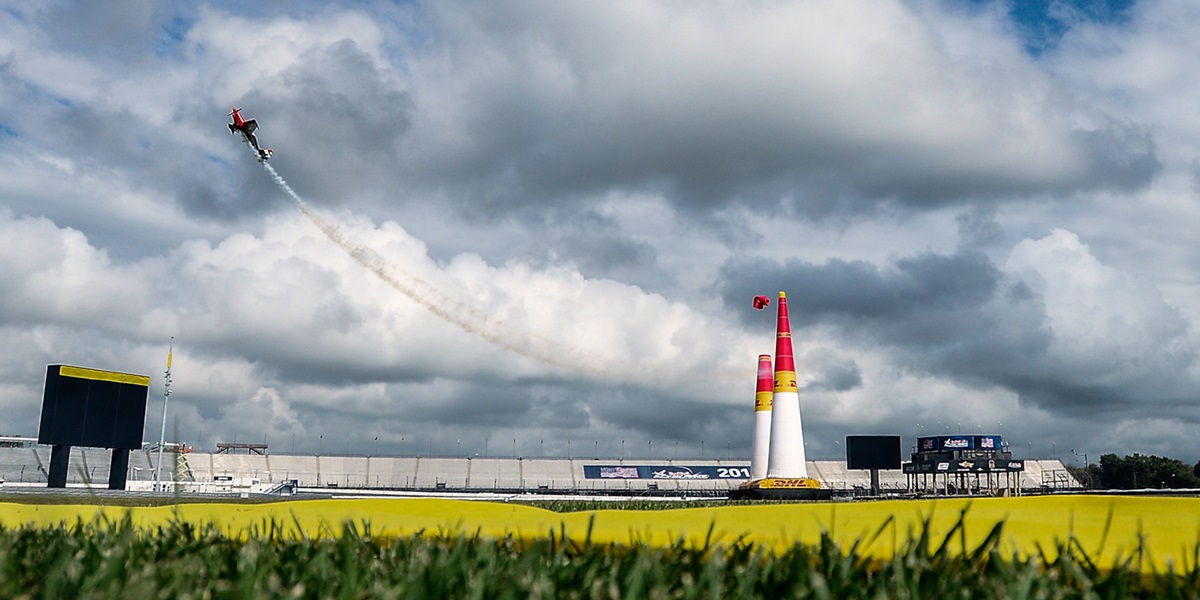
Red Bull Air Race 101: Going Fast, Yet Smooth
September 30, 2016 | By Phillip B. Wilson
The essence of this weekend’s inaugural Red Bull Air Race World Championship isn’t unlike a normal racing event at the Indianapolis Motor Speedway.
It’s just airplanes instead of race cars.
Granted, these airplanes are pulling 10Gs as opposed to Indy cars pulling 3Gs, but there are several similarities.
Their fastest competitive speeds are around 230 mph. Races are against the clock with outcomes sometimes decided by as scant a margin as a tenth of a second. Any impact with anything and the resulting penalty will likely cost a competitor the race. And crews work feverishly to prepare a plan for pilots to execute in qualifying and the race.
“On the ground, you have to have a good plan with your team, you analyze all the data, the videos, to get the good lines through the track in order to keep the energy and to keep the speed of the plane,” Spain’s Juan Velarde said after Friday’s masters class practice session.
Just like the Verizon IndyCar Series has a feeder system with Indy Lights, airplane racing as a Masters Class with 14 pilots and a feeder series in the Challenger Cup. Velarde finished 13th in his Master Class debut last season. He’s 11th this season.
Frenchman Nicolas Ivanoff led the initial practice session with a time of 1 minute, 3.672 seconds after completing three laps on the 1.85-mile layout inside IMS. American Kirby Chambliss was third at 1:03.921. In the Challenger Class, American Kevin Coleman ranked second with a time of 1 minute, 16.865 seconds.
“You have to go over hundreds of things in your head,” Velarde said.
Several penalties can prove costly. Exceed the maximum entry speed through the start gate, that’s an additional second. If a plane is deemed to have wings at an incorrect flying level through a gate, that’s two seconds. Flying too high through a gate, two seconds. If a plane’s wing strikes one of the course’s gate pylons, that’s three seconds. Deviate from the course and the run is stopped. Fail to meet the minimum pilot and race plane weight of 1,534 pounds (with a tolerance of 11 pounds post-flight) and that’s a disqualification.
Saturday’s schedule has Challenger Cup practice at 10:45 a.m. and qualifying at 3:05 p.m. Master Class practice is at 1:40 p.m. and qualifying at 4:05 p.m. Pilots are then slotted in a seeded bracket; two planes compete in a heat and the fastest advances. The Challenger Cup race begins at noon Sunday. The Master Class competition is at 3:05 p.m.
“You go through the track many, many times and try to represent in your mind what you’re going to see during the flight because in the flight everything goes so fast that you don’t have time almost to think,” Velarde said. “Once you’re up there, you have trouble with the penalties, hitting the pylons. You have to focus on getting the airplane right in the line that you planned before, that way you fly as smoothly as you can. You have to pull 10Gs, but smooth. It’s kind of a strange thing. It’s like the airplane is an arrow and you have to fly like an arrow and keep the speed.
“Sometimes, you have a difference of a tenth of a second, even a thousandth of a second. When you lose by ten thousandth of a second, it’s very difficult to analyze. Yeah, everything counts. Absolutely everything counts. Your physical preparation, mental preparation, the airplane, the teamwork. It’s much more complex than it appears.”
This is the seventh of eight races to decide the championship. Masters points leader Matthias Dolderer of Germany can clinch his first championship this weekend if he finishes first or second. Australian Matt Hall is a distant second, 16.5 points behind. The top-10 finishers are awarded points with the winner receiving 15, runner-up 12, third place nine, fourth seven, fifth six, sixth five, seventh four, eighth three, ninth two and 10th one.
Velarde, 42, grew up a son of a pilot in Madrid and has had aspirations to race planes from an early age.
“I’m a professional airline pilot and since quite young I started and I’ve always had this in mind, what I could do in an airplane,” he said. “I ended up here, which is for me the absolute top where you can be as a sport pilot. It’s fantastic. The atmosphere is very good with the rest of the pilots. We’re very competitive but very friendly at the same time.”